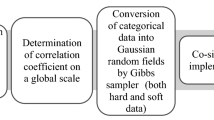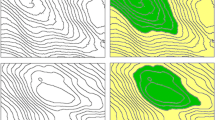Abstract
The plurigaussian model is increasingly used for simulating geo-domains and quantifying geological uncertainty in the subsurface. However, because they rely on the truncation of only two Gaussian random fields, the current implementations of this model are often restricted in the number of geo-domains that can be simulated and in their contact relationships. A solution to overcome these restrictions is to increase the number of underlying Gaussian random fields. Such an approach yields a very flexible model, able to reproduce the contact relationships between geo-domains in agreement with their chronology (i.e., such that younger geo-domains cross-cut the older ones), as well as the geo-domain proportions and spatial correlation structure. The proposed approach is applied to a dataset from the Río Blanco copper deposit in the Chilean Central Andes, in which it is of interest to simulate the layout of seven rock units (andesite, granitoid, tourmaline breccia, monolithic breccia, magmatic breccia, porphyry and pipe). The results are used to map the probabilities of occurrence of the rock units and to identify the sectors where the interpreted rock model is uncertain.














Similar content being viewed by others
References
Allard D, D’Or D, Biver P, Froidevaux R (2012) Non-parametric diagrams for plurigaussian simulations of lithologies. In: Ninth international geostatistics congress, Oslo. http://geostats2012.nr.no/pdfs/1746887.pdf. Accessed 23 Nov 2014
Armstrong M, Galli A, Beucher H, Le Loc’h G, Renard D, Doligez B, Eschard R, Geffroy F (2011) Plurigaussian simulations in geosciences. Springer, Berlin
Carrasco P, Ibarra F, Rojas R, Le Loc’h G, Séguret S (2007) Application of the truncated Gaussian simulation method to a porphyry copper deposit. In: Magri E (ed) 33rd International symposium on applications of computers and operations research in the mineral industry, Gecamin, Santiago, pp 31–39
Chilès JP, Delfiner P (2012) Geostatistics: modeling spatial uncertainty, 2nd edn. Wiley, New York
Cressie NAC (1993) Statistics for spatial data, rev edn. Wiley, New York
De Marsily G, Delay F, Gonçalves J, Renard P, Teles V, Violette S (2005) Dealing with spatial heterogeneity. Hydrogeol J 13(1):161–183
Deraisme J, Field M (2006) Geostatistical simulations of kimberlite orebodies: application to sampling optimization. In: Dominy S (ed) 6th International mining geology conference, Darwin. Australasian Institute of Mining and Metallurgy, Melbourne, pp 193–203
Deutsch CV (2002) Geostatistical reservoir modeling. Oxford University Press, New York
Deutsch JL, Deutsch CV (2014) A multidimensional scaling approach to enforce reproduction of transition probabilities in truncated plurigaussian simulation. Stoch Environ Res Risk Assess 28(3):707–716
Dowd PA, Pardo-Igúzquiza E, Xu C (2003) Plurigau: a computer program for simulating spatial facies using the truncated plurigaussian method. Comput Geosci 29(2):123–141
Emery X (2007) Simulation of geological domains using the plurigaussian model: new developments and computer programs. Comput Geosci 32(9):1189–1201
Emery X (2010) Iterative algorithms for fitting a linear model of coregionalization. Comput Geosci 36(9):1150–1160
Emery X, González KE (2007a) Incorporating the uncertainty in geological boundaries into mineral resources evaluation. J Geol Soc India 69(1):29–38
Emery X, González KE (2007b) Probabilistic modelling of lithological domains and its application to resources evaluation. J S Afr Inst Min Metall 107(12):803–809
Emery X, Ortiz JM, Cáceres AM (2008) Geostatistical modelling of rock type domains with spatially varying proportions: application to a porphyry copper deposit. J S Afr Inst Min Metall 108(5):285–292
Fontaine L, Beucher H (2006) Simulation of the Muyumkum uranium roll front deposit by using truncated plurigaussian method. In: Dominy S (ed) 6th International mining geology conference, Darwin. Australasian Institute of Mining and Metallurgy, Melbourne, pp 205–215
Frikken PH (2003) Breccia-hosted copper-molybdenum mineralization at Río Blanco, Chile. PhD Dissertation. University of Tasmania, Australia
Frikken PH, Cooke DR, Walshe JL, Archibald D, Skarmeta J, Serrano L, Vargas R (2005) Mineralogical and isotopic zonation in the Sur-Sur tourmaline breccia, Río Blanco-Los Bronces Cu-Mo deposit, Chile: implications for ore genesis. Econ Geol 100:935–961
Galli A, Beucher H, Le Loc’h G, Doligez B, Heresim Group (1994) The pros and cons of the truncated Gaussian method. In: Armstrong M, Dowd PA (eds) Geostatistical simulations. Kluwer, Dordrecht, pp 217–233
Hollings P, Cooke D, Clark A (2005) Regional geochemistry of tertiary igneous rocks in Central Chile: implications for the geodynamic environment of giant porphyry copper and epithermal gold mineralization. Econ Geol 100:887–904
Jeannée N, Bardou E, Faucheux C, Ornstein P (2013) Geostatistical assessment of ice content distribution within the Glacier Bonnard. Math Geosci 45:591–599
Journel AG, Alabert FG (1990) New method for reservoir mapping. J Pet Technol 42(2):212–218
Journel AG, Huijbregts CJ (1978) Mining geostatistics. Academic Press, London
Kay SM, Mpodozis C (2001) Central Andes ore deposits linked to evolving shallow subduction systems and thickening crust. GSA Today 11:4–9
Kay SM, Mpodozis C (2002) Magmatism as a probe to the Neogene shallowing of the Nazca plate beneath the modern Chilean flat-slab. J S Am Earth Sci 15:39–57
Kay SM, Mpodozis C, Coira B (1999) Neogene magmatism, tectonism and mineral deposits of the central Andes. In: Skinner BJ (ed) Geology and ore deposits of the Central Andes. Special Publication No. 7. Society of Economic Geologists, Littleton, pp 7–59
Kyriakidis PC, Deutsch CV, Grant ML (1999) Calculation of the normal scores variogram used for truncated Gaussian lithofacies simulation: theory and Fortran code. Comput Geosci 25(2):161–169
Lantuéjoul C (2002) Geostatistical simulation: models and algorithms. Springer, Berlin
Le Loc’h G, Galli A (1997) Truncated plurigaussian method: theoretical and practical points of view. In: Baafi EY, Schofield NA (eds) Geostatistics Wollongong’ 96. Kluwer, Dordrecht, pp 211–222
Mariethoz G, Renard P, Cornaton F, Jaquet O (2009) Truncated plurigaussian simulations to characterize aquifer heterogeneity. Ground Water 47(1):13–24
Matheron G, Beucher H, de Fouquet C, Galli A, Guerillot D, Ravenne C (1987) Conditional simulation of the geometry of fluvio-deltaic reservoirs. In: 62nd Annual technical conference and exhibition of the society of petroleum engineers, pp 591–599. SPE Technical Paper 16753
Matheron G, Beucher H, de Fouquet C, Galli A, Ravenne C (1988) Simulation conditionelle à trois facies d’une falaise de la formation du Brent. Sciences de la Terre, Série Informatique Géologique 28:213–249
Rezaee H, Asghari O, Koneshloo M, Ortiz JM (2014) Multiple-point geostatistical simulation of dykes: application at Sungun porphyry copper system, Iran. Stoch Environ Res Risk Assess 28(7):1913–1927
Rondon O (2009) A look at the plurigaussian simulation for a nickel laterite deposit. In: Dominy S (ed) 7th International mining & geology conference. The Australasian Institute of Mining and Metallurgy, Melbourne
Serrano L, Vargas R, Stambuk V, Aguilar C, Galeb M, Holmgren C, Contreras A, Godoy S, Vela I, Skewes MA, Stern CR (1996) The late Miocene to early Pliocene Río Blanco-Los Bronces copper deposit, Central Chilean Andes. In: Camus F, Sillitoe RH, Petersen R (eds) Andean copper deposits: new discoveries, mineralization, styles and metallogeny. Special Publication No. 5. Society of Economic Geologists, Littleton, pp 119–130
Skewes MA, Stern CR (1995) Genesis of the late Miocene to Pliocene copper deposits of central Chile in the context of Andean magmatic and tectonic evolution. Int Geol Rev 37:893–909
Skewes MA, Stern CR (1996) Late Miocene mineralized breccias in the Andes of central Chile: Sr and Nd isotopic evidence for multiple magmatic sources. In: Camus F, Sillitoe RH, Petersen R (eds) Andean copper deposits: new discoveries, mineralization, styles and metallogeny. Special Publication No. 5. Society of Economic Geologists, Littleton, pp 119–130
Skewes MA, Holmgren C, Stern CR (2003) The Donoso copper-rich, tourmaline-bearing breccia pipe in central Chile: petrologic, fluid inclusion and stable isotope evidence for an origin from magmatic fluids. Miner Deposita 38(1):2–21
Skvortsova T, Armstrong M, Beucher H, Forkes J, Thwaites A, Turner R (2001) Applying plurigaussian simulations to a granite-hosted orebody. In: Kleingeld WJ, Krige DG (eds) Geostats 200 Cape Town. Geostatistical Association of Southern Africa, Johannesburg, pp 904–911
Skvortsova T, Beucher H, Armstrong M, Forkes J, Thwaites A, Turner R (2002) Simulating the geometry of a granite-hosted uranium orebody. In: Armstrong M, Bettini C, Champigny N, Galli A, Remacre A (eds) Geostatistics Rio 2000. Kluwer, Dordrecht, pp 85–99
Stambuk V, Aguilar C, Blondel J, Galeb M, Serrano L, Vargas R (1988) Geología del yacimiento Río Blanco. Technical Report. Codelco-Chile, División Andina
Strebelle S (2002) Conditional simulation of complex geological structures using multiple-point statistics. Math Geol 34(1):1–22
Talebi H, Asghari O, Emery X (2013) Application of plurigaussian simulation to delineate the layout of alteration domains in Sungun copper deposit. Cent Eur J Geosci 5(4):514–522
Talebi H, Asghari O, Emery X (2014) Simulation of the lately injected dykes in an Iranian porphyry copper deposit using the plurigaussian model. Arab J Geosci 7(7):2771–2780
Vargas R, Gustafson LB, Vukasovic M, Tidy E, Skewes MA (1999) Ore breccias in the Río Blanco-Los Bronces copper deposit, Chile. In: Skinner BJ (ed) Geology and ore deposits of the Central Andes. Special Publication No. 7. Society of Economic Geologists, Littleton, pp 281–297
Warnaars F, Holgrem C, Barassi S (1985) Porphyry copper and tourmaline breccias at Los Bronces—Río Blanco, Chile. Econ Geol 80:1544–1565
Xu C, Dowd PA, Mardia KV, Fowell RJ (2006) A flexible true plurigaussian code for spatial facies simulations. Comput Geosci 32(10):1629–1645
Yunsel T, Ersoy A (2011) Geological modeling of gold deposit based on grade domaining using plurigaussian simulation technique. Nat Resour Res 20(4):1–19
Yunsel T, Ersoy A (2013) Geological modeling of rock type domains in the Balya (Turkey) lead-zinc deposit using plurigaussian simulation. Cent Eur J Geosci 5(1):77–89
Acknowledgments
This research was funded by the Chilean Commission for Scientific and Technological Research, through Project CONICYT/FONDECYT/REGULAR/No. 1130085. The authors acknowledge the support from Claudio Martínez from Codelco-Chile (Andina Division), who provided the dataset used in this work, as well as the comments by Grégoire Mariethoz and another anonymous reviewer, who helped to improve the manuscript.
Author information
Authors and Affiliations
Corresponding author
Rights and permissions
About this article
Cite this article
Madani, N., Emery, X. Simulation of geo-domains accounting for chronology and contact relationships: application to the Río Blanco copper deposit. Stoch Environ Res Risk Assess 29, 2173–2191 (2015). https://doi.org/10.1007/s00477-014-0997-x
Published:
Issue Date:
DOI: https://doi.org/10.1007/s00477-014-0997-x




